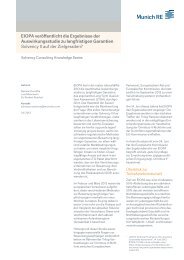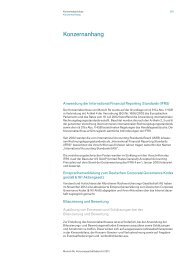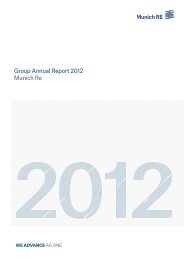Munich Re Group Annual Report 2006 (PDF, 1.8
Munich Re Group Annual Report 2006 (PDF, 1.8
Munich Re Group Annual Report 2006 (PDF, 1.8
Create successful ePaper yourself
Turn your PDF publications into a flip-book with our unique Google optimized e-Paper software.
<strong>Munich</strong> <strong>Re</strong> <strong>Group</strong> <strong>Annual</strong> <strong>Re</strong>port <strong>2006</strong> Notes_Equity and liabilities<br />
these provisions are posted on the basis of national regulations, a<br />
retrospective approach is usually taken based on supervisory or individual<br />
contract regulations. Besides this, there are provisions for<br />
deferred premium refunds, which are posted for the amounts apportionable<br />
to policyholders from the valuation differences between<br />
IFRS and local GAAP on the basis of the expected future participation<br />
quotas. For unrealised gains and losses on investments available for<br />
sale, which are recognised directly in equity (see assets item B), the<br />
resultant provision for deferred premium refunds is also posted<br />
without impact on profit or loss; otherwise, changes in the provision<br />
for deferred premium refunds are recognised in the income statement.<br />
All technical provisions are regularly subjected to a liability adequacy<br />
test in accordance with IFRS 4. If current experience shows<br />
that the provisions posted on the basis of the original assumptions –<br />
less the related deferred acquisition costs and the present value of<br />
the related premiums – is inadequate to cover the expected future<br />
benefits, we adjust the technical provisions with recognition in profit<br />
or loss. The appropriateness of unearned premiums and of the provision<br />
for outstanding claims is assessed in relation to the realistically<br />
estimated future amount to be paid. The appropriateness of the provision<br />
for future policy benefits is assessed on the basis of realistic<br />
estimates of the actuarial assumptions, the proportional investment<br />
result and, for contracts with participation in surplus, the future profit<br />
sharing.<br />
D Gross technical provisions for life insurance policies where the<br />
investment risk is borne by the policyholders<br />
This item includes the provision for future policy benefits in life primary<br />
insurance where policyholders bear the investment risk themselves<br />
(unit-linked life insurance). The value of the provision for<br />
future policy benefits essentially corresponds to the market value<br />
of the relevant investments shown under assets item C. Besides this,<br />
as under the provision for future policy benefits as per FAS 97, they<br />
may include additional premium components; cf. the notes on assets<br />
item C. Changes in this provision are fully recognised in the underwriting<br />
result. Insofar as these changes derive from unrealised gains<br />
and losses from alterations in the fair values of the related investments,<br />
they are matched by opposite changes of the same amount<br />
in the investment result.<br />
E Other accrued liabilities<br />
This item includes provisions for post-employment benefits. The<br />
companies in the <strong>Munich</strong> <strong>Re</strong> <strong>Group</strong> generally give commitments to<br />
their staff in the form of defined contribution plans or defined benefit<br />
plans. The type and amount of the pension obligations are determined<br />
by the conditions of the respective pension plan. In general,<br />
they are based on the staff member’s length of service and salary.<br />
Under defined contribution plans, the companies pay fixed contributions<br />
to an insurer or a pension fund. This fully covers the com-<br />
panies’ obligations. Under defined benefit plans, the staff member is<br />
promised a particular level of retirement benefit either by the companies<br />
or by a pension fund. The companies’ contributions needed<br />
to finance this are not fixed in advance. If pension obligations are<br />
covered by assets held by a legally separate entity (e.g. a fund or a<br />
contractual trust agreement in the form of a two-way trust) – assets<br />
that may only be used to cover the pension commitments given and<br />
are not accessible to creditors – the pension obligations are shown<br />
less the amount of these plan assets. If the fair value of the plan<br />
assets exceeds the related outsourced pension obligations, this<br />
repayment claim is shown under “other receivables”. Pension<br />
obligations are recognised in accordance with IAS 19 (Employee<br />
Benefits) using the projected unit credit method and based on actuarial<br />
studies. The calculation includes not only the pension entitlements<br />
and current pensions known on the balance sheet date but<br />
also their expected future development.<br />
The interest rate at which the pension obligations are discounted<br />
is based on the yields for long-term high-quality bonds (e.g. government<br />
bonds). Actuarial gains or losses from pension obligations and<br />
plan assets result from the deviation of actual risk experience from<br />
estimated risk experience. They are recognised directly in equity,<br />
without impact on profit or loss.<br />
Tax provisions for current taxes are posted – without discounting –<br />
in accordance with the probable tax payments for the year under<br />
review or previous years.<br />
Other provisions are established in the amount of the probable<br />
requirement; such amounts are not discounted if the interest-rate<br />
effect is insignificant.<br />
F Liabilities<br />
This item comprises bonds and notes issued, deposits retained on<br />
ceded business and other liabilities. Financial liabilities are recognised<br />
at amortised cost. The value of the option components of<br />
ERGO International AG’s exchangeable bonds converted or<br />
redeemed in the financial year was determined as the difference<br />
between the market price of the exchangeable bonds and the value<br />
of the bond components calculated on the basis of current market<br />
yields. Direct minority interests in special funds are measured at fair<br />
value.<br />
G Deferred tax liabilities<br />
Under IAS 12, deferred tax liabilities must be recognised if asset<br />
items have to be valued higher, or liabilities items lower, in the consolidated<br />
balance sheet than in the tax accounts of the reporting<br />
company and these differences will be eliminated at a later date with<br />
a corresponding impact on taxable income (temporary differences);<br />
cf. notes on assets item H.<br />
163

















